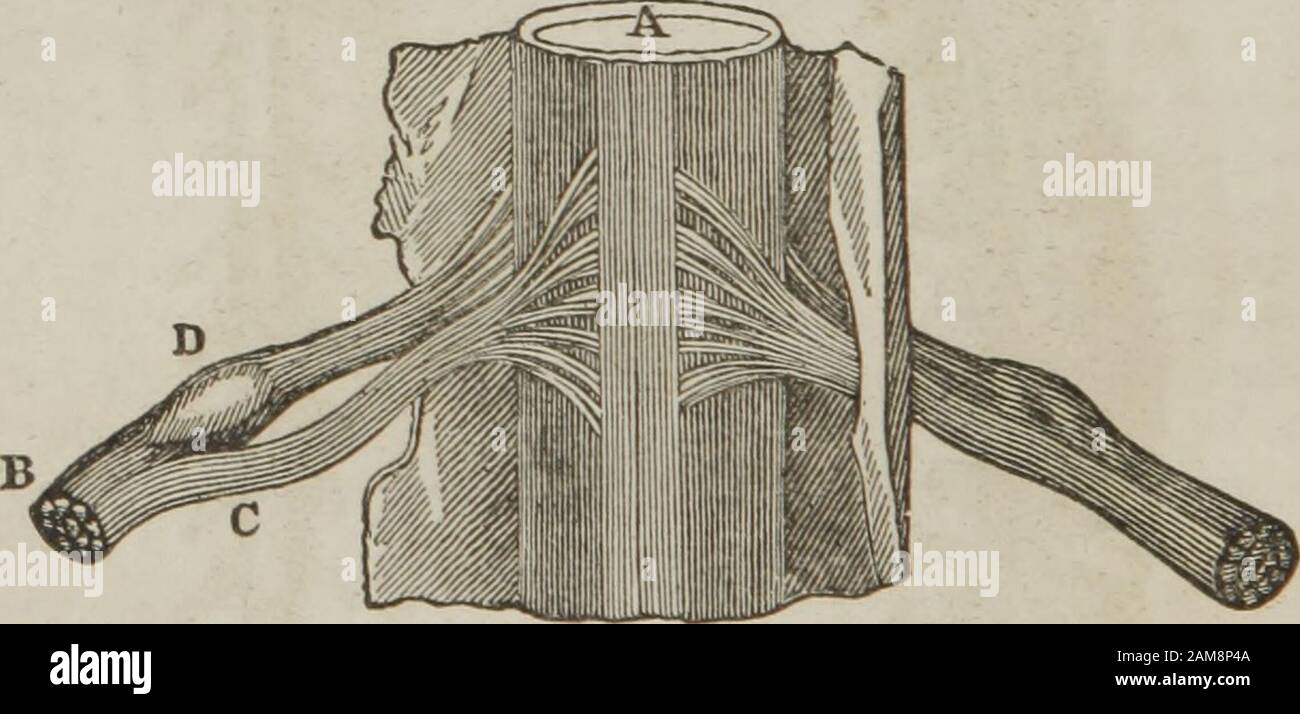Anatomy and physiology : designed for academies and families . l cord, surroundeaby its sheath. Twenty-nine pairs of nerves are seen coining from it, each nerve nav-iog an enlargement named a ganglion. An anterior and posterior fissure divides the spinal cordinto two lateral cords. These are united by a thin layer ofwhite substance. The lateral cords are each divided by fur-rows, into three columns, viz., anterior, lateral, and posterior. The anterior are the motor columns, and give origin to themotor roots of the spinal nerves. The posterior are the columns of sensation, and give originto the

Image details
Contributor:
The Reading Room / Alamy Stock PhotoImage ID:
2AM8P4AFile size:
7.1 MB (270.3 KB Compressed download)Releases:
Model - no | Property - noDo I need a release?Dimensions:
2281 x 1095 px | 38.6 x 18.5 cm | 15.2 x 7.3 inches | 150dpiMore information:
This image is a public domain image, which means either that copyright has expired in the image or the copyright holder has waived their copyright. Alamy charges you a fee for access to the high resolution copy of the image.
This image could have imperfections as it’s either historical or reportage.
Anatomy and physiology : designed for academies and families . l cord, surroundeaby its sheath. Twenty-nine pairs of nerves are seen coining from it, each nerve nav-iog an enlargement named a ganglion. An anterior and posterior fissure divides the spinal cordinto two lateral cords. These are united by a thin layer ofwhite substance. The lateral cords are each divided by fur-rows, into three columns, viz., anterior, lateral, and posterior. The anterior are the motor columns, and give origin to themotor roots of the spinal nerves. The posterior are the columns of sensation, and give originto the sensitive roots of the spinal nerves. The lateral columns are divided in their function betweenmotion and sensation. They contain the fasciculus describedby Sir Charles Bell as the respiratory tract. THE SPINAL NERVES. There are thirty-one pairs of spinal nerves, each arising bytwo roots — an anterior, or motive root; and a posterior, orsensitive root. The anterior roots arise from a narrow white line upon theanterior columns of the spinal cord. Fig. 175.. Fig. 175. A Represents the spinal cord, surrounded by Its sheath. B, A spinalnerve, formed by the union of the motor root, (C, ) and the sensitive root, (D.) At D, the ganglion upon this root is seen. Into how many parts is the spinal cord divided ? How are these cordsunited ? Name the divisions of the lateral cords. What is the function ofthe anterior column ? The posterior? The lateral columns? How manypairs of nerves issue from the spinal cord ? Give the origin/of the anteriorroots. THE SPINAL NEftVES. 253 The posterior roots arise from a narrow gray band formedby the internal gray substance of the cord. They are larger, and the filaments of origin more numerous than those of theanterior roots. A ganglion is found upon each of the poste-rior roots in the foramina, or holes between the bones of thevertebra through which the nerve passes. Fig. 176. Fig. 177.